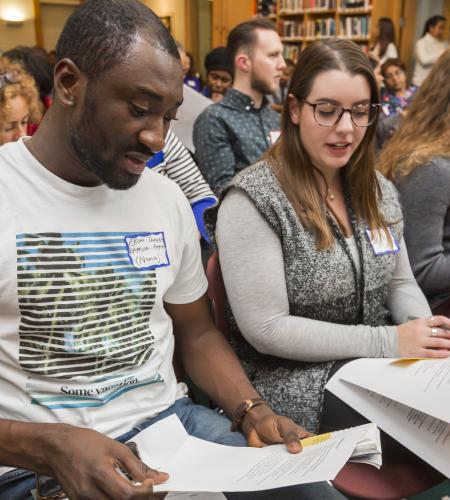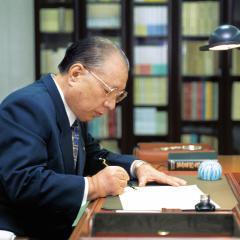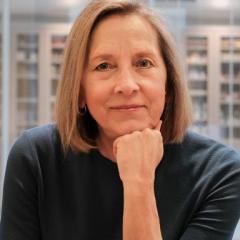On Wednesday, February 27, 2019, the School for Conflict Analysis and Resolution (S-CAR) at George Mason University (GMU) hosted a book launch panel discussion event for Peacebuilding Through Dialogue: Education, Human Transformation, and Conflict Resolution, which the Ikeda Center developed and published in collaboration with George Mason University Press. The panel featured three contributors to the volume that live in the D.C. area: lead editor Peter Stearns, Provost Emeritus and University Professor at GMU; Susan Allen, Associate Professor at S-CAR and Director of its Center for Peacemaking Practice; and Mark Farr, President of the Sustained Dialogue Institute. The Dean of S-CAR, Kevin Avruch, moderated, and Kevin Maher and Mitch Bogen of the Ikeda Center offered some opening remarks.
Roughly thirty participants – a mixture of S-CAR faculty members and students, area peacebuilding professionals, and local residents – attended the event, which was also livestreamed via Facebook. More than 300 people viewed the event in real time, and there have now been more than 750 views of the video.
Ikeda on Dialogue
In his opening words, Kevin Maher introduced the work and mission of the Ikeda Center. He also highlighted Mr. Ikeda’s commitment to dialogue and peace, including his belief that, “Dialogue is not some simplistic assertion of one’s own position, nor is it necessarily about persuading others to one’s point of view. Dialogue is about demonstrating respect for another’s life, and being determined to learn when confronted with differences in personality and perspective.”
Mitch Bogen then presented ideas from Daisaku Ikeda’s foreword, and from his work in general, that provide a philosophical foundation for a commitment to dialogue and illuminate the guiding principles of the book.
- It is a mistake to prejudge people as being of greater or lesser value or pre-categorize people into “simplistic binaries” of good or bad, friend and foe, etc.
- The Buddhist perspective holds that no identity is fixed, and all of us are in possession of ten inner realms, ranging from hunger and anger to learning and realization all the way up to Buddhahood, that manifest in accordance with how we act in our environments
- Engaging in openhearted, open-minded dialogue is actually a more realistic response to conflict or path to lasting and just social change than methods based on coercion.
- There is an intimate relationship between inner and outer or social change, beautifully expressed in the concept of “human revolution” which holds, in Mr. Ikeda’s words, that “A great human revolution in just a single individual will enable a change in the destiny of all humankind.”
Taken together, these ideas represent some of the most essential frames of mind that help us to do two vital things: They inspire us to believe in the possibility and power of dialogue and they prepare us to be participants in successful peacebuilding dialogue when the opportunity arises.
Panelist Presentations
In his presentation, Dr. Stearns said it was a privilege to serve as editor for the book, especially because of his respect for Daisaku Ikeda and the work of the Ikeda Center. He added that through working on the book, he learned a lot more about dialogue than he knew before. One key finding from his research was how interest in dialogue “fluctuates historically,” with a long trough occurring during the era of imperialism and empire in the nineteenth century and into the twentieth. This makes sense, suggested Professor Stearns, since in an imperial era the dominant countries believe they have “all the answers.” However, since 1950 there has been a steadily ascending curve in published references to dialogue, which suggests an increase both in the perceived need for dialogue and the capacity to facilitate it. Dr. Stearns added that Peacebuilding Through Dialogue attempts to build on this trend and that he finds both the surge of interest in dialogue and the increase in dialogical expertise very encouraging.
Rev. Farr explained that his chapter sought to explore dimensions of dialogue by looking at his own long and quite varied experience as a dialogician, which makes him something of a “dialogue mongrel,” he added. Among these experiences: many years engaging in dialogue with congregants in his role as an Episcopalian minister; high level experience as a leader of the Faith and Politics Institute on Capitol Hill; work with a Buddhist foundation as a dialogue consultant; and most recently, his current work with the Sustained Dialogue Institute (SDI). He quoted his mentor Hal Saunders, founder of SDI, who would often say, “all problems are humanly created and therefore can be humanly uncreated.” For Farr this is a hopeful point, because if it is true that humans can change, difficult situations can be changed as well. He also emphasized something that came from his experience with the Buddhist-grounded dialogue project, namely the importance of people being in a relationship in a fresh way, not burdened by narratives and prejudices about a given past or present conflict that can tend to polarize us.
Dr. Allen began by saying she is honored to have had a chapter in this book and that she has enjoyed engaging with the variety of perspectives communicated in it. During her presentation, she introduced five different approaches to peacemaking dialogue, with special attention to the core characteristics found within these approaches. Specifically, she highlighted how:
- Dialogues are learning opportunities. When people come into dialogues ready to learn, things work. When people don’t want to learn, working to arouse their curiosity can help.
- Dialogues engage “the moral imagination.” Successful dialogue asks us to surrender control and be “open to other possibilities.”
- Dialogues typically, but not always, engage facilitators, someone who can “hold the process.”
- Dialogue honors participants as meaning makers possessing dignity.
- Dialogues can shift in focus. For example, they can move from a focus on understanding to a focus on planning.
To conclude, Dr. Allen stressed that we should think creatively about how dialogue can be practiced more often in our everyday lives. Dialogues don’t always have to be formal. They can be as informal and casual as the dialogues that happen in book groups.
Q&A and Open Dialogue
Dean Avruch began the group dialogue portion of the event by asking the panelists about the main themes that connected the experience and practice of dialogue across the three main sections of the book: education, personal and interpersonal transformation, and conflict resolution. Dr. Stearns said that, in his view, all dialogue, no matter the context, requires two things: an openness to learning and a willingness to engage in self-reflection. Susan Allen noted that, as she suggested during her remarks, sometimes this openness and willingness doesn’t come easily for people and they need to be coaxed and encouraged. The basic characteristic of true dialogue is acknowledgement of human connection, she added. Mark Farr added that all dialogues must contain an explicit discussion of the circumstances of each participant, especially in regard to their relative power.
An interesting sub-thread of this opening conversation had to do with whether dialogue has a role in the less subjective educational settings, such as the engineering classroom. Dr. Stearns responded, “vigorously, yes,” not least because the work of engineers always involves engagement with human communities. Reverend Farr followed up, drawing a comparison between the immutable laws of physics that engineers must deal with and what might be called the immutable “law of God” that many religious believers must accommodate and contend with in any religiously-oriented dialogue. Indeed, said Farr, “many of the fault lines of the world’s conflicts run down the fault lines of religion.”
Moving to questions and comments from attendees, the first important point raised was that every dialogue needs to take into account the differing cultures that dialogue participants bring to an encounter. Too often dialogue has been seen as a situation where dialogue experts from the West “parachute” into a conflict situation armed only with their “models” but not an awareness of the cultures they would be working in. Dr. Allen said that one way past that is for the facilitators themselves to be able and open to learning, on the spot and in real time. Dr. Avruch mentioned that while respect for indigenous culture is key, that shouldn’t mean tacit acceptance of unjust aspects of that culture, such as patriarchy or social stratification.
One attendee asked Mark Farr about what he learned about dialogue from his experience as a priest. Rev. Farr said that the presence of God as part of the dialogue can provide a “hook” or an anchor point that helps a dialogue when other human connection might be weak. That being the case, said Farr, the truth is that we are all connected, regardless of the presence of a deity, adding that this is something expressed well in Buddhism. Dr. Stearns added that this task of getting people to acknowledge the humanness of the other is the biggest challenge in creating the conditions for successful dialogue to take place. Dr. Avruch agreed, but said this human connection is essential, although not always sufficient. There often are structural obstacles, political or economic, that hinder progress even when human connection is there.
Two attendees asked about the importance of setting and environment in relation to dialogue. The panelists agreed that warm and welcoming environments impact whether dialogue can flourish and succeed. Rev. Farr mentioned a dialogue he conducted with leaders from Russia and the United States, where in the formal setting of the conference room, no progress occurred. However when the same people met informally at a countryside estate, their defenses were dropped, and they acknowledged the others’ point of view. Dr. Allen added that calm settings in nature are often best, which is what you will find, for example, at S-CAR’s Point of View retreat center on the Potomac. Nevertheless, even a “windowless basement room” can also become a sacred space, if the intention of participants is there.
Finally, when asked what makes the book unique, Dean Avruch responded that with its emphasis on dialogue as a humanistic practice, the book is part of the new trend in the field that emphasizes “heart” feeling as opposed to just focusing on cognitive or behavioral components, the main focus of dialogical negotiations in the early years after World War II. He also mentioned that a focus more on being surprised or on learning new things as opposed to reaching agreement is a fresh direction also demonstrated by Peacebuilding Through Dialogue.


